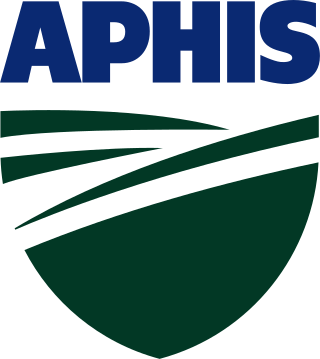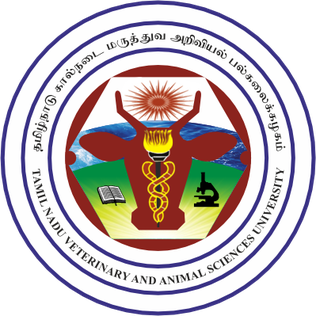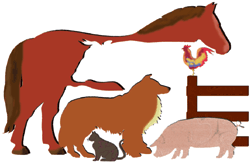The World Organisation for Animal Health (WOAH), formerly the Office International des Epizooties (OIE), is an intergovernmental organisation founded in 1924, coordinating, supporting and promoting animal disease control. The primary objective of WOAH is to control epizootic diseases and prevent their spread. Further objectives include the sharing of transparent, scientific information; international solidarity; sanitary safety; and the promotion of veterinary services‚ food safety and animal welfare.
Ferdowsi University of Mashhad is a public university in Mashhad, the capital city of the Iranian province of Razavi Khorasan. FUM is named after Abul-Qâsem Ferdowsi Tusi, who is considered to be the national epic poet of Greater Iran. Having been established in 1949, FUM is the third-oldest modern university in Iran.
The American Society for the Prevention of Cruelty to Animals (ASPCA) is a non-profit organization dedicated to preventing animal cruelty. Based in New York City since its inception in 1866, the organization's mission is "to provide effective means for the prevention of cruelty to animals throughout the United States."

A veterinarian (vet) or veterinary surgeon is a medical professional who practices veterinary medicine. They manage a wide range of health conditions and injuries in non-human animals. Along with this, veterinarians also play a role in animal reproduction, health management, conservation, husbandry and breeding and preventive medicine like nutrition, vaccination and parasitic control as well as biosecurity and zoonotic disease surveillance and prevention.

The Animal and Plant Health Inspection Service (APHIS) is an agency of the United States Department of Agriculture (USDA) based in Riverdale, Maryland responsible for protecting animal health, animal welfare, and plant health. APHIS is the lead agency for collaboration with other agencies to protect U.S. agriculture from invasive pests and diseases. APHIS's PPQ is the National Plant Protection Organization for the U.S., and the agency's head of veterinary services/veterinary Deputy Administrator is the Chief Veterinary Officer of the United States.

Tamil Nadu University of Veterinary and Animal Sciences (TANUVAS) is a veterinary university founded in 1989 in Madhavaram Milk Colony, Chennai, India. It is composed of the Madras Veterinary College, Vepery, Veterinary College and Research Institute, Namakkal, Veterinary College and Research Institute, Tirunelveli; Veterinary College and Research Institute, Orathanadu, Thanjavur and the Institute of Food and Dairy Technology, Koduvalli, Chennai-52. Research farms are for leprosy bacteria, for prawn and edible fish culture, and for animal feed safety.

The American Veterinary Medical Association (AVMA) is an American not-for-profit association founded in 1863 that represents more than 105,000 veterinarians.
The National Association of State Public Health Veterinarians (NASPHV) develops and publishes uniform public health procedures involving zoonotic disease in the United States and its territories. These veterinarians work closely with emergency rooms, legislators, local officials, schools, health departments, and the general public to prevent disease exposure and control diseases that are transmitted to humans from animals and animal products.
A veterinary specialist is a veterinarian who specializes in a clinical field of veterinary medicine.

The Royal Army Veterinary Corps (RAVC), known as the Army Veterinary Corps (AVC) until it gained the royal prefix on 27 November 1918, is an administrative and operational branch of the British Army responsible for the provision, training and care of animals. They are also responsible for explosives and drug search dogs. It is a small corps, forming part of the Army Medical Services.

The Center for Veterinary Medicine (CVM) is a branch of the U.S. Food and Drug Administration (FDA) that regulates the manufacture and distribution of food, food additives, and drugs that will be given to animals. These include animals from which human foods are derived, as well as food additives and drugs for pets or companion animals. CVM is responsible for regulating drugs, devices, and food additives given to, or used on, over one hundred million companion animals, plus millions of poultry, cattle, swine, and minor animal species. Minor animal species include animals other than cattle, swine, chickens, turkeys, horses, dogs, and cats.
Chief veterinary officer (CVO) is the head of a veterinary authority. They have the responsibility and competence for ensuring or supervising the implementation in their nation of animal health and welfare measures, international veterinary certification and other standards and recommendations. The World Organization for Animal Health recognizes the notion of chief veterinary officers. The Council of the European Union also realizes the importance of the chief veterinary officers, and founded a preparatory body called Working Party of Chief Veterinary Officers. Typical responsibilities of a chief veterinary officer are to organize and operate a country's animal health and animal protection service and veterinary public health service, covering food chain safety, control of zoonoses, environmental contamination and role of animals in the society.

Bernard Elliot Rollin was an American philosopher, who was emeritus professor of philosophy, animal sciences, and biomedical sciences at Colorado State University. He is considered the "father of veterinary medical ethics".

The Canadian Federation of Humane Societies (CFHS), branded as Humane Canada, is a non-profit animal welfare organization in Canada, representing humane societies, SPCAs, and animal rescue organizations. The organization's stated goal is to promote the welfare and humane treatment of animals and work to end animal cruelty.

Bondi Vet is an Australian factual television series. It follows the lives of veterinary surgeon Chris Brown at the Bondi Junction Veterinary Hospital, and emergency veterinarian Lisa Chimes at the Small Animal Specialist Hospital (SASH), in the Sydney suburb of North Ryde.

Phi Zeta (ΦΖ) is the only honor society of veterinary medicine in the United States.

The Iranian Anti-Vivisection Association (IAVA) is a nonprofit nongovernmental science-based organization. It's the first animal rights advocacy group in Iran which professionally campaigns for lab animal rights. In 2012, IAVA was recognized as Iran's most active animal rights group and was awarded the Brown Bear statuette by Iran Animal Rights Watch and a number of environmental parties.
The UCPH School of Veterinary Medicine and Animal Science is part of the Faculty of Health and Medical Sciences at University of Copenhagen (UCPH) in Copenhagen, Denmark. Based at the university's Frederiksberg Campus in Frederiksberg and the Taastrup Campus in the suburb of Taastrup, the school originates in the Royal Veterinary and Agricultural University which was merged into UCPH in 2007. It is the only institution that trains veterinarians in Denmark. The programme is taught in two veterinary teaching hospitals, one at the Frederiksberg Campus and one for large animals in Taastrup.
The British Columbia Society for the Prevention of Cruelty to Animals is a non-profit animal welfare organization which advocates for animal protection legislation, operates animal shelters, and runs educational workshops and public awareness programs throughout British Columbia, Canada. Founded in 1896, it is a registered charitable organization and one of the largest such animal welfare organizations in North America. As of 2017, BC SPCA had 36 branches, over 500 staff members, nearly 5500 volunteers, operated 5 veterinary hospitals/clinics and a wildlife rehabilitation centre, and sheltered more than 22000 animals. It is also one of the few animal welfare organizations to monitor animals in film.

Rajasthan University of Veterinary and Animal Sciences (RAJUVAS) is a state agricultural university located at Bikaner, Rajasthan, India. It was established in 2010 by the Rajasthan University of Veterinary and Animal Sciences Act, 2010 of the Government of Rajasthan, amended in 2013. Its constituent colleges are College of Veterinary and Animal Science, Bikaner, College of Veterinary and Animal Science, Navania, Vallabhnagar, Udaipur and Post Graduate Institute of Veterinary Education and Research (PGIVER). It also has 65 other institutes awarding two-year diplomas.











